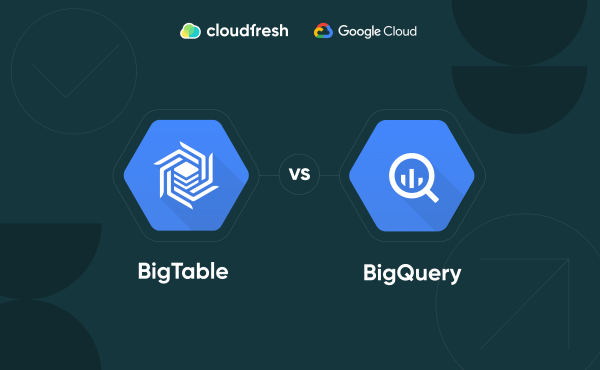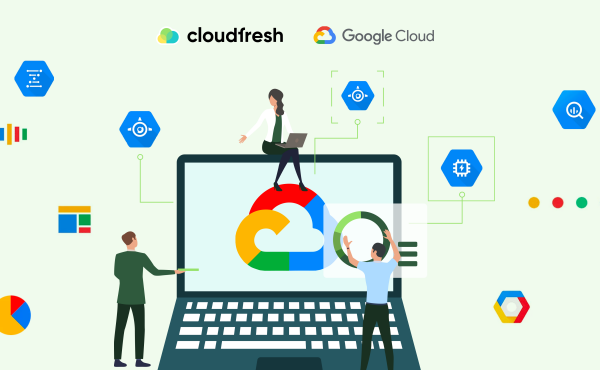How-to Guide: Mastering Cloud Migration
Data Lake vs Data Warehouse

Data lakes and data warehouses are essential tools in data analytics, yet it’s crucial to note they’re not interchangeable. Mixing up these storage types is common, but they’re more different than alike. Understanding this matters because each has unique roles and needs different top-performance approaches. While a data lake works for one company, a data warehouse may be a better fit for another — some might even need both to thrive.
In this blog, we will plunge into the key distinctions of data lake and data warehouse and dive deeper into the Google Cloud (further, GCP) data lake and data warehouse solutions to understand the perfect choice for your company.
What is a Data lake?
Imagine a data lake as a vast reservoir purposely built to collect and house an extensive array of raw data in all its forms. Whether structured, semi-structured, or entirely unstructured, this repository accommodates it all. This lays the foundation for users to dive into diverse tasks — think big data processing, SQL queries, text mining, streaming analytics, and even machine learning. This is a tool that allows you to store any data: csv, xml, json, parquet, jpg, png, mov, mp3, pdf and others.
You can load tables that do not have a clear structure into them; that is, the number and names of columns and rows change periodically. All this data can be loaded into the lake without processing, which happens almost instantly. Once nestled within the data lake, this data becomes a treasure trove for machine learning and artificial intelligence (AI) algorithms, serving myriad business needs. After processing, it may find its way to a data warehouse for further utilization.
Today, businesses are shifting their focus to data lake solutions, seeing beyond just storing precise data. It’s not only about accuracy but also about gaining deeper insights into various business scenarios. This richer context is accelerating analyses like never before.
Primarily designed for handling vast volumes of big data, data lakes offer businesses the flexibility to bring in raw data, be it in batches or streams, without immediate transformation.
Companies leverage data lakes to:
- Reduce TCO (Total Cost of Ownership)
- Simplify data management
- Prep for integrating artificial intelligence and machine learning
- Boost analysis processes
- Enhance security and governance
What is a Data warehouse?
Unlike a data lake, a data warehouse is a meticulously structured historical data that has been processed for a defined purpose. Think of data warehouses like real warehouses – they process and sort data into specialized “shelves” known as data marts. These warehouses are designed to store well-organized data from various sources like relational databases. They utilize online analytical processing (OLAP) for data analysis. Data warehouses (see our comparison on BigQuery vs Snowflake) also handle vital tasks like extracting, cleansing, transforming, and more to ensure the data is ready for in-depth analysis.
Modern businesses require not just large-scale data analysis but also continuous real-time insights. Consider service providers adjusting prices dynamically throughout the day or insurance companies meticulously tracking policies, sales, claims, and more while harnessing machine learning to anticipate fraud. Even in gaming, companies closely monitor user behavior to enhance the player experience on the spot. Data warehouses make all of these endeavors possible.
Data warehouse will help your organization to deal with :
- Multiple diverse data sources
- Analyzing and visualizing big data, both in real-time and asynchronously
- Utilizing machine learning/AI
- Flow analysis
- Ad hoc analytics or custom reporting
- Data mining
- Data Science
Differences between Data lake and Data warehouse
Data lakes and warehouses handle data, but each has its specialty and role. Large organizations often use both because they complement each other. They create a secure system to store, process, and quickly analyze data.
A data lake collects all sorts of data — from business apps, social media, or devices—without organizing or structuring it immediately. This “schema-on-read” approach allows storing various data types in their raw form, from structured to unstructured, in large amounts.
On the other hand, a data warehouse is more organized. It’s built with a specific structure based on business needs and is designed for easy SQL querying. Unlike a data lake that stores raw data, a data warehouse stores structured data ready for specific analyses or reports, making it great for standard business reports and predefined purposes.
In simple terms, a data lake collects all kinds of data without immediate organization, while a data warehouse holds structured data that are ready for specific kinds of analysis or reports. Both are important and work together for better data analysis in big organizations.
| Parameters | Data Lake | Data Warehouse |
| Data type | Raw data of all types, irrespective of structure | Processed data, organized based on metrics and attributes |
| Data purpose | Intended for future determination and analysis | Currently in use for various operations |
| Process | Extract Load Transform (ELT) | Extract Transform Load (ETL) |
| Shema | Defined after data storage | Defined before data storage |
| Impact | Speeds up data capture and storage process | Delays data processing but ensures consistency and confidence in data usage across the organization |
| Scalability | Easy to scale at a low cost | Difficult and expensive to scale |
| Users | Data scientists, those requiring in-depth analysis and predictive modeling | Business professionals, operational needs |
| Accessibility | Easily accessible and updatable | Complex for making alterations |
| Applications | Predictive analytics, machine learning, data visualization, BI, big data analytics | Data visualization, BI, data analytics |
| Cost | Lower storage costs, reduced management time | Higher costs, increased management time |
In a data lake, data isn’t neatly organized beforehand. This means data scientists and self-service BI tools can dive into a wider array of data much quicker than in a data warehouse.
Why it’s powerful:
- It’s cost-effective to store heaps of structured and unstructured data like ERP transactions and call logs.
- Keeping data raw means lightning-fast accessibility.
- You can explore a broader spectrum of data, uncovering fresh insights that were once out of reach.
On the other hand, data warehouses are a treasure trove for organizations, especially in the realm of BI and analytics. Once cleansed and processed, this data becomes a reliable “single source of truth” crucial for insightful business analysis, collaboration, and decision-making.
What are the data warehouse benefits:
- No or minimal data prep hassle, making it a breeze for analysts and business users to dive in.
- Swift access to accurate, comprehensive data speeds up the transformation from information to valuable insights.
- Unified and consistent data serves as a trusted foundation, fostering confidence in decision-making across the board.
BigQuery: all-in-one solution
Google Cloud presents a lineup of auto-scaling cloud data lakes and data warehouse services designed to craft your personalized GCP data lake, aligning perfectly with your applications, expertise, and IT investments. Among them are Dataflow and Cloud Data Fusion for seamless data ingestion, Cloud Storage for secure storage, and Dataproc and BigQuery for top-notch data processing and analytics.
Let’s dive a little bit deeper into BigQuery. BigQuery, Google Cloud’s all-in-one enterprise data warehousing solution, is crafted to empower swift, informed decisions, keeping your business ahead of the competition. With this service, you can skip the hassle of setting up or handling infrastructure — analyze data, save costs, share insights, and drive your digital evolution smoothly.
BigQuery’s full separation of storage and computing allows BigQuery computing to be brought to other storage mechanisms through federated queries. It means that BigQuery separates where it keeps information and where it does the work with that information. BigQuery storage API allows treating a data warehouse like a data lake. It helps you get to the information stored in BigQuery.
Moreover, BigQuery has its own ML system that lets you build and run machine learning (ML) models using Google SQL queries. There is no need for extensive programming skills in Python or Java. It democratizes ML and AI, empowering analysts to create models and leverage AI APIs within the data warehouse.
This streamlines processes, reducing complexity and accelerating model innovation without moving vast amounts of data around.
Conclusions
Certain companies thrive with data lakes, especially those harnessing raw data for machine learning advancements. Conversely, data warehouses suit other enterprises better, particularly those where business analysts rely on structured analytics for operational insights. Each model stands out for its unique structure, process, users, and flexibility. Crafting the ideal data lake, data warehouse, or both, tailored to your company’s needs, will drive significant growth.
As a Google Cloud Premier Partner, we would be happy to assist you with leveraging BigQuery, Cloud SQL, Cloud Storage, Data Proc, and other Google data lake and warehouse solutions to modernize your IT infrastructure and turn your company into a data-driven organization.
Contact our Google Cloud consultants, and we will cover all your requests!












